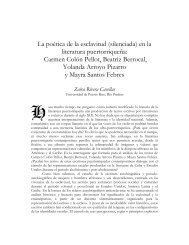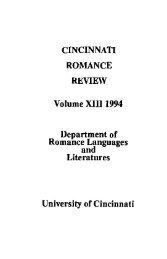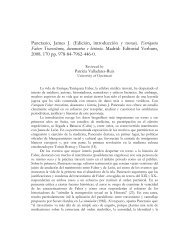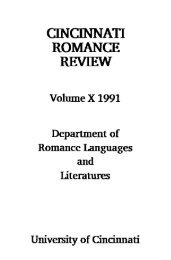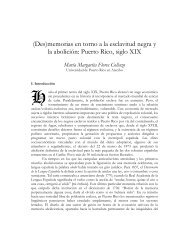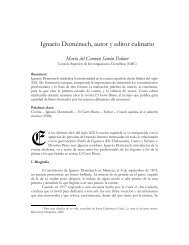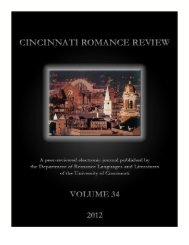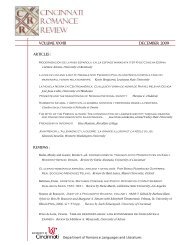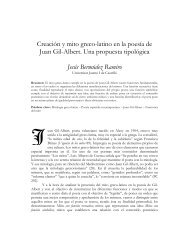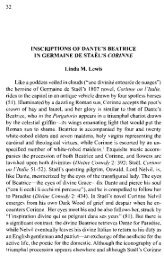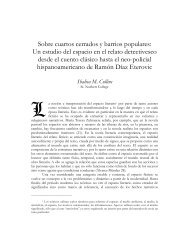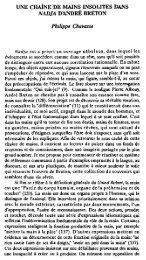Volume 30 (2011) - Cincinnati Romance Review
Volume 30 (2011) - Cincinnati Romance Review
Volume 30 (2011) - Cincinnati Romance Review
You also want an ePaper? Increase the reach of your titles
YUMPU automatically turns print PDFs into web optimized ePapers that Google loves.
“DOUBLE CONSCIOUSNESS/DOUBLE BIND” 71<br />
puertorriqueña, ‘mujer’ y ‘raza’ típicamente se analizan de forma separada” (74). These<br />
texts illustrate that it is impossible to study race without discussing gender.. Not only<br />
did the authors challenge societal norms as women but their works clearly elucidate that<br />
their color further hindered their literary reception as female authors; both poets gained<br />
recognition after their deaths. Furthermore, a nation-building rhetoric of anti-blackness<br />
complicated their identification as mulatas because Puerto Rico desired to obscure the<br />
black masses and disputed the legitimacy of the mulato in the social, political, and<br />
cultural matrix.<br />
In the early twentieth-century (19<strong>30</strong>s and 1940s), a national discourse of<br />
hispanidad erased blackness from the Puerto Rican national imaginary. Intellectuals such<br />
as Antonio Pedreira (Insularismo 1934) and Tomás Blanco (El prejuicio racial en Puerto Rico<br />
1942) minimized the black presence on the Island and emphasized the country’s<br />
Spanish heritage to thwart North American imperialism. Desiring to eliminate<br />
blackness from the racial paradigm, Pedreira disputed the mulato’s place in Puerto Rican<br />
society and argued for assimilation through racial mixing:<br />
Entre una, que es la superior, y la otra, que es la inferior, el mulato será<br />
siempre elemento fronterizo, participante de ambas tendencias raciales<br />
que acrecentará más o menos de acuerdo con el tipo que escoja para un<br />
segundo enlace: el mestizo, el blanco o el negro. El mulato, que<br />
combina en sí las dos últimas y generalmente no suele ser una cosa ni la<br />
otra, es un tipo de fondo indefinido y titubeante, que mantiene en<br />
agitación ambas tendencias antropológicas sin acabar de perfilarse<br />
socialmente. Vive del presente inmediato, definiéndose de todos y de sí<br />
mismo, sin volcar pautas en el ambiente, prudente e indeciso, como el<br />
hombre que se encuentra cogido entre dos fuegos. Necesita mayor<br />
cantidad de reservas de una u otra raza para resolver su situación. Es<br />
hombre de grupo que colabora y no crea, que sigue y no inicia, que<br />
marcha en fila y no es puntero. Por lo general, carece de fervores para<br />
ser capitán. (35)<br />
Thus, this text found that the mulato, the hybrid intermediary between the<br />
European and African, to be a threat to the creation of a homogeneous white Puerto<br />
Rican society; Pedreira perceived the mulato to be just as much of an impediment to the<br />
advancement of the nation as the black African. Furthermore, these texts and others<br />
propagated national myths of homogeneity that argued that racial prejudice does not<br />
exist or described it as “innocent child’s play”. In El prejuicio racial en Puerto Rico, Blanco<br />
noted, “No hay negros puros en Puerto Rico” and further argued that Puerto Rican<br />
culture was “blanca, occidental con muy pocas y ligerísimas influencias no españolas”<br />
(Roy-Féquiére “Negrismo” 211). Needless to say, “[r]ace, racial identification, and<br />
racialist thinking were key elements of the Puerto Rican negrista controversy” (Roy-<br />
<strong>Cincinnati</strong> <strong>Romance</strong> <strong>Review</strong> <strong>30</strong> (Winter <strong>2011</strong>): 69-82.



